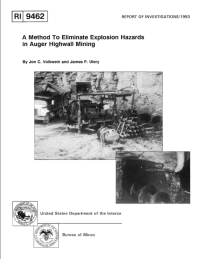Mining Publication: A Method To Eliminate Explosion Hazards in Auger Highwall Mining
Original creation date: January 1993
The U.S. Bureau of Mines investigated a method of using inert gas to prevent the formation of explosive gas mixtures in auger highwall mining of coal. A combination of gasoline and diesel engine exhaust gases was introduced into the auger drill hole using a short section of pipe located at the collar. Gas samples were taken and analyzed on-site with infrared detectors for oxygen, carbon dioxide, methane, and carbon monoxide. Evacuated bottle samples were also taken and analyzed by gas chromatography in the laboratory. These gas results were analyzed for explosibility. Coal samples from various depths were used to obtain the gas content of the coal using the modified direct method. Personal exposure to carbon monoxide was also monitored. The highest methane level observed was 9.55%. The levels of inert gas (carbon dioxide and nitrogen) were sufficiently high to prevent any ignition of the methane. Results showed that for all conditions during mining, gas concentrations were nonexplosive. The gas content of the coal was about 0.30 cm3/g. The maximum personal time-weighted average sample for carbon monoxide was 20 ppm. This system provides a safe, inexpensive, simple method for preventing explosions during auger mining.
Authors: JC Volkwein, JP Ulery
Report of Investigations - January 1993
NIOSHTIC2 Number: 10012096
Pittsburgh, PA: U.S. Department of the Interior, Bureau of Mines, NTIS No. PB93-190411, RI 9462, 1993 Jan; :1-14
See Also
- Analysis of Highwall Mining Stability - The Effect of Multiple Seams and Prior Auger Mining on Design
- Analysis of Practical Ground Control Issues in Highwall Mining
- ARMPS-HWM - Analysis of Retreat Mining Pillar Stability - Highwall Mining - 1.3.02
- Control and Monitoring of Gas in Blind Auger Headings
- Development of an Anti-Caking Rock Dust
- Electrical Equipment Explosion Protection Research
- Inertization Technologies
- Technology News 462 - Ground Penetrating Radar for Highwall Guidance
- Teleoperation of a Highwall Mining System
- The Use of Nitrogen-Enhanced Foam at the Pinnacle Mine Fire
- Content source: National Institute for Occupational Safety and Health, Mining Program


 ShareCompartir
ShareCompartir
